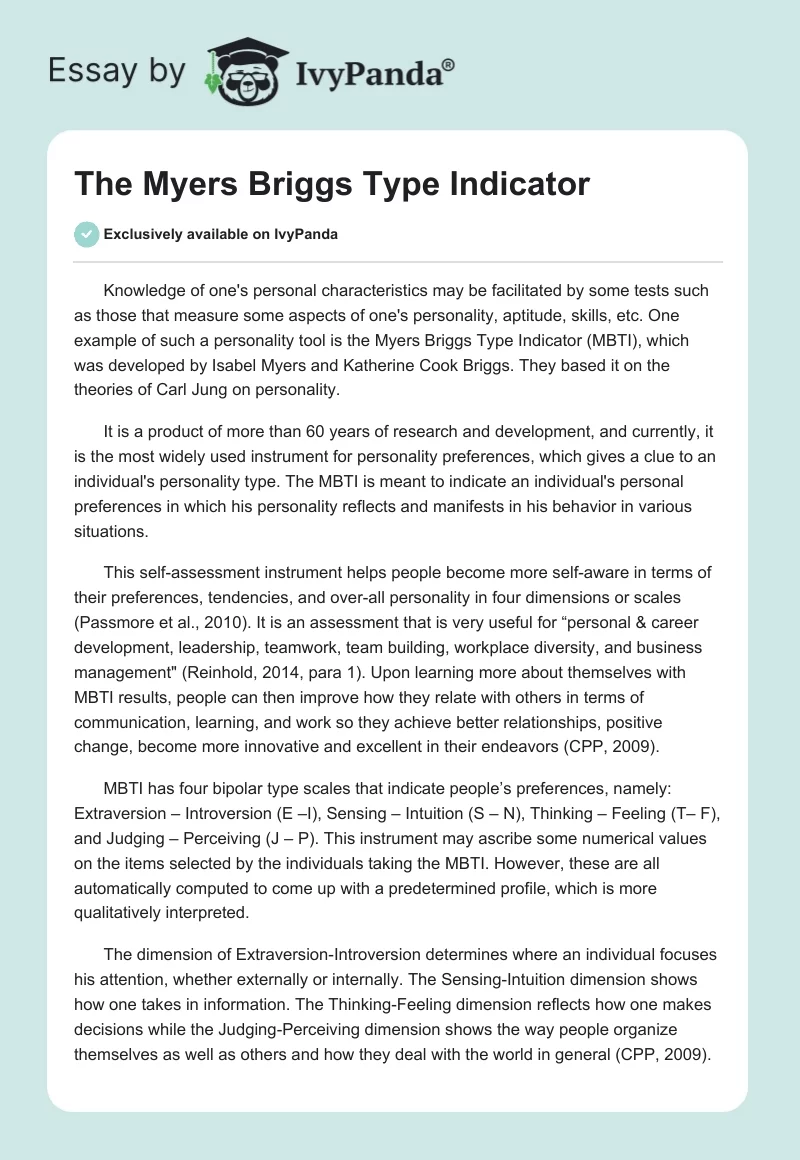Knowledge of one’s personal characteristics may be facilitated by some tests such as those that measure some aspects of one’s personality, aptitude, skills, etc. One example of such a personality tool is the Myers Briggs Type Indicator (MBTI), which was developed by Isabel Myers and Katherine Cook Briggs. They based it on the theories of Carl Jung on personality.
It is a product of more than 60 years of research and development, and currently, it is the most widely used instrument for personality preferences, which gives a clue to an individual’s personality type. The MBTI is meant to indicate an individual’s personal preferences in which his personality reflects and manifests in his behavior in various situations.
This self-assessment instrument helps people become more self-aware in terms of their preferences, tendencies, and over-all personality in four dimensions or scales (Passmore et al., 2010). It is an assessment that is very useful for “personal & career development, leadership, teamwork, team building, workplace diversity, and business management” (Reinhold, 2014, para 1). Upon learning more about themselves with MBTI results, people can then improve how they relate with others in terms of communication, learning, and work so they achieve better relationships, positive change, become more innovative and excellent in their endeavors (CPP, 2009).
MBTI has four bipolar type scales that indicate people’s preferences, namely: Extraversion – Introversion (E –I), Sensing – Intuition (S – N), Thinking – Feeling (T– F), and Judging – Perceiving (J – P). This instrument may ascribe some numerical values on the items selected by the individuals taking the MBTI. However, these are all automatically computed to come up with a predetermined profile, which is more qualitatively interpreted.
The dimension of Extraversion-Introversion determines where an individual focuses his attention, whether externally or internally. The Sensing-Intuition dimension shows how one takes in information. The Thinking-Feeling dimension reflects how one makes decisions while the Judging-Perceiving dimension shows the way people organize themselves as well as others and how they deal with the world in general (CPP, 2009).
It was explained by Myers (1993) that people who have a more extraverted preference show tendencies to act on the environment in creating an effect, however those with a more introverted preference derive energy from the environment and uses it to generate ideas and emotions internally. Those who manifest a judging preference tend to make decisions in order to seek closure through purposeful action, but those with perceiving preference are more open to ideas and changes and have a more spontaneous and adaptable personality.
People with sensing preference acquire their experiences through the use of their senses and focus on those experiences while those with intuitive preference rely on feelings on the possible things that can happen. Finally, individuals with thinking preferences link ideas and make connections and are sometimes regarded as analytical and cold. On the other hand, people who have a feeling of preference can show more empathy and understanding to others (Hirsch & Kummerow, 1998). These eight preferences may be combined to form sixteen possible personality profiles or types.
Careers that may seem to provide individuals with the opportunities to express or use their psychological type preferences may be the most desired for people who have determined their MBTI personality type. The MBTI may provide ideas on an individual’s personality type; however, it does not explain other factors such as his interests and skills, which are necessary to consider in decision-making. However, all types can make contributions to all career fields.
Although MBTI may be very useful in guiding people to decide on a career that best suits their personality type, Zunker (2012) cautions that personalities can grow and change. Such types may reflect temporal characteristics of how individuals interact with the environment. One should also assess skills and abilities for the type of work desired and not just preferences. MBTI should be a guide in reflecting on the continually evolving personality traits of the individual and how such changes can affect his decisions for a career choice.
MBTI results may provide some revelations to individuals which they were not aware of previously. Some may agree with the personality type MBTI has drawn up for them and some may not. However, it should be stressed that MBTI does not encompass everything about the individual’s personality. It can provide them more awareness of their preferences or what how their personalities are prone to respond to certain situations. In any case, assessment instruments such as MBTI are useful in creating new learning experiences (Zunker, 2012).
The preferences identified in the instrument can be further exploited to the advantage of the individual. Clients should be advised that MBTI results are not the “end-all and be-all” of their personalities and should only be considered as a helpful guide in how to better improve themselves towards their chosen careers. It is essential that they keep on being introspective, develop more interests and skills and interact with more people to further develop their personalities.
MBTI is a culturally-sensitive assessment tool because it takes into consideration universal norms. It is available in more than 20 languages, “with new translations in the pipeline and with culturally appropriate norms for each country for which a translation is available” (CPP, 2009, para. 3). Hence, this tool can be used by anyone seeking more self-awareness and self-improvement in their lives.
References
CPP (2009) Myers-Briggs Type Indicator (MBTI), Web.
Hirsch, S. K. and Kummerow, J. (1998) Introduction to Type in Organizations, California: Consulting Psychologists Press.
Myers, I. B. (1993), Introduction to Type, 5th edn, California: Consulting Psychologist Press.
Passmore, J., Holloway, M. and Rawle-Cope, M. (2010) Using MBTI type to explore differences and the implications for practice for therapists and coaches: Are executive coaches really like counsellors?, Counselling Psychology Quarterly, 23 (1), 1–16.
Reinhold, R. (2014) Using the MBTI & Myers Briggs Personality Types, Web.
Zunker, V.G. (2012) Career counseling: A holistic approach (8th ed.). Belmont, CA: Cengage, Brooks/Cole.


